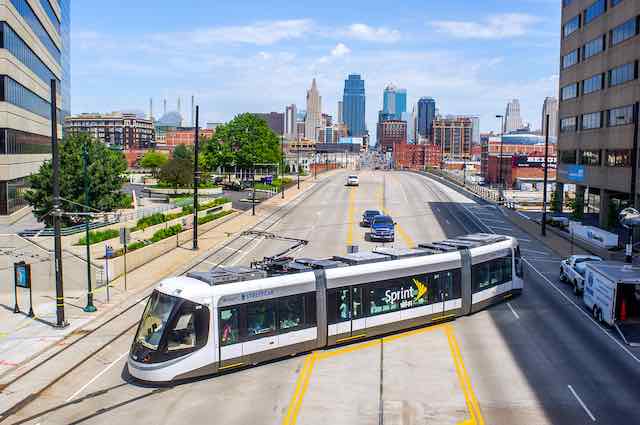“When I go shopping,” said Cordelia Chase, the vapid “mean girl” in Buffy the Vampire Slayer, “I have to have the most expensive thing, not because it’s expensive, but because it costs more.” That seems to be the rule guiding Ramsey County, home of St. Paul, Minnesota.
A streetcar in Kansas City heroically manages to block five lanes of traffic all at once. Photo by Jason Doss.
The county is considering two major alternatives for a transit line from St. Paul Union Depot (SPUD) to the Mall of America (MOA) via Minneapolis-St. Paul Airport (MSP): a modern streetcar, which can move less than 3,000 people per hour at about 16 miles per hour and would cost $2.1 billion; and a bus-rapid transit line that could move 10,000 to 20,000 people per hour supposedly at 18 miles per hour (but I bet it could run much faster) and is estimated to cost $121 million to build and half as much to operate as the streetcar line.
Naturally, the county has selected the streetcar, much to the distress of some local taxpayers who don’t seem to understand Transit Logic. In its defense, the county points out that the modern streetcars are “nationally and internationally becoming a standard for transit development.”
“Many cities in the United States have well developed modern streetcar networks,” it continues, “like San Francisco and Seattle with many more cities expanding streetcar service such as Kansas City, Milwaukee, and Detroit.” San Francisco and Seattle hardly have “well developed streetcar networks” as San Francisco’s is only 9.3 miles long and uses heritage streetcars, not modern streetcars, while Seattle’s two little streetcar lines total less than four miles long.
Nor can any of the lines in these cities be considered great successes. Seattle’s two routes carried only about 3,400 riders a day in 2022. Milwaukee’s 2.5-mile route carried only 1,000 a day. Detroit’s 3.4-mile route carried fewer than 1,700 a day. Kansas City’s 2-mile route did better having carried almost 2,700 people a day. San Francisco’s did best having carried 7,700 a day, but it is more than 9 miles long and well integrated into the city’s light-rail system. Significantly, none of them charge a fare except San Francisco and even in San Francisco fare collection is on the honor system so fares averaged just 50 cents a ride.
What’s going on is that Ramsey County is suffering from Light-Rail Envy, as neighboring Hennepin County (home of Minneapolis) has a light-rail line from downtown Minneapolis to the MOA via MSP. Why the county picked streetcars when the rest of the region is using light rail is puzzling. Streetcars are supposed to cost less than light rail, but the 11.9-mile route from SPUD to MOA via MSP is expected to cost more than $175 million a mile, which is light-rail territory, and in the end will no doubt cost much more.
I can’t tell from planning documents whether the portion of the streetcar between Fort Snelling and Mall of America would duplicate the existing light-rail line or use that line’s tracks. Using the same tracks would reduce the line’s capacity even more. Light rail and streetcar tracks can move about 20 trains an hour. If half those trains are light rail from Minneapolis, then the streetcar line can move only 10 trains an hour — which mean it’s capacity is less than 1,500 people an hour. On the other hand, duplicating the line would be a huge waste demonstrating just inadequacies of both streetcars as super-low-capacity transit and light rail as low-capacity transit.
Of course, none of the documents distributed by Ramsey County hint at this capacity limit. Instead, they compare a “standard bus” which supposedly can carry “48 passengers” (in fact, most standard buses are rated to carry 60) with a modern streetcar that supposedly carry 146 passengers (which is reasonable even if it is unlikely that any modern streetcar ever carries that many people).
Left unmentioned are the articulated or “bendy” buses often used for bus-rapid transit, which can easily carry well over 100 people. Also left unmentioned is that bus-rapid transit lines can easily move more than 160 buses per hour — some move well over 250 — bringing their capacity to 10,000 to 25,000 people per hour depending on the size of buses used.
Light rail (which Ramsey County says can hold 175 people per car)can be run in three-car trains and thus can move 10,500 people per hour, and yet this wasn’t even seriously considered as an alternative for rather specious reasons (see page 23). Clearly, Ramsey County doesn’t think many people are going to use this line: it is predicting at most 11,600 per day. This means it is settling for a super-low-capacity system that comes with a super-high price tag. So the question is: did they pick the streetcar because it is more expensive or because it costs more?









I would think the decision came down to operating costs, plans for future expansion, and possibly issues with grade separation. Trams lines are cheaper to operate than bus lines due to the durability of trams, the tracks, and overhead wires, with the added bonus of reducing the number of drivers you need to pay to move the same number of people. This plus the fact that a highway runs into the airport, which the mall sits across from, , means that either they would have to construct a grade separated light rail crossing or install a tram tracks integration to the underpass nearby. Granted my understanding of teh difference between light rail and tram lines is that light rail is more grade separated to reduce stoppages on the route and allow for speed increases.
mb I seemed to miss the operating cost bit. so now idk probably just plans for future expansion.